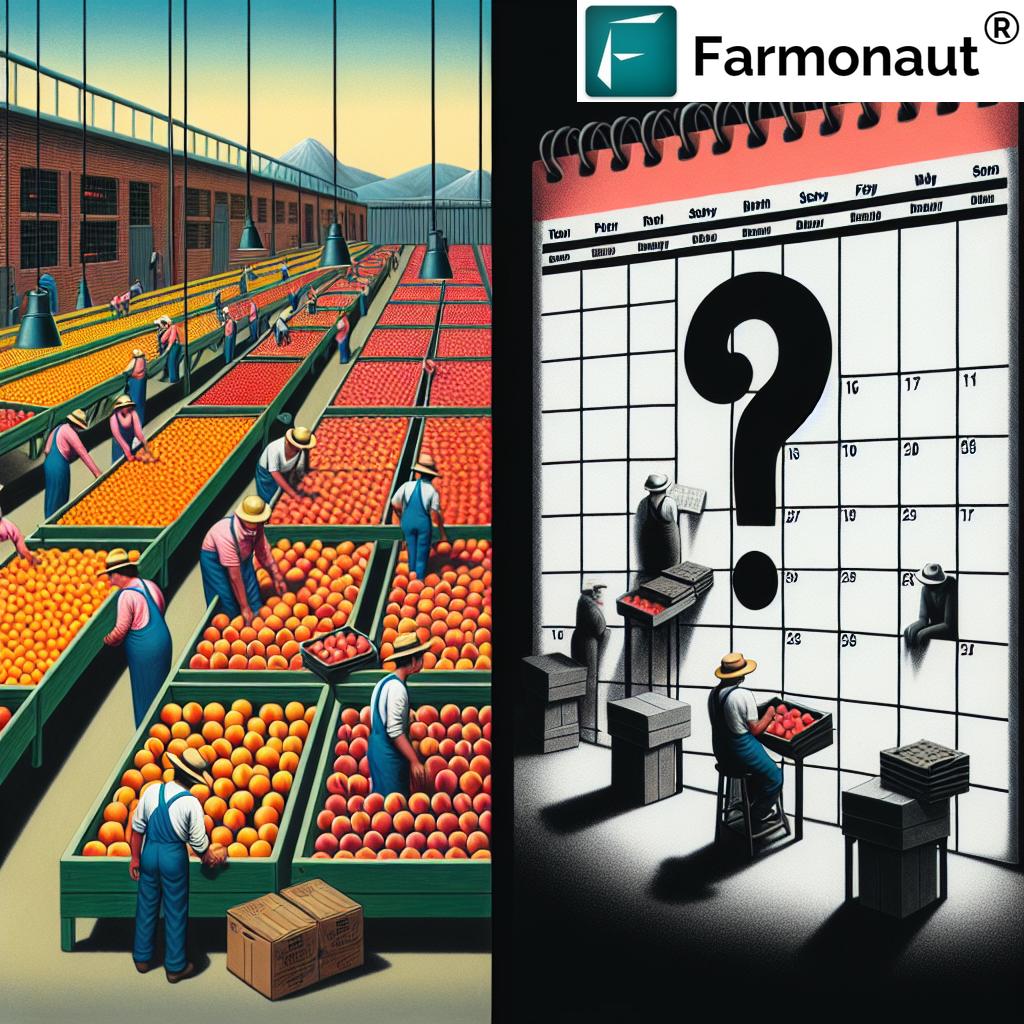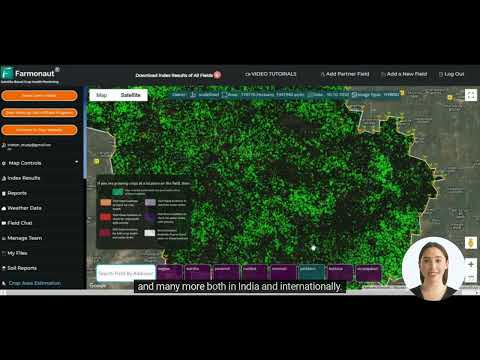Georgia’s Peach Industry Faces Labor Crisis: How Immigration Policies Impact Seasonal Harvests
“Georgia’s peach industry relies on H-2A visa program for up to 80% of its seasonal workforce.”
In the heart of Crawford County, Georgia, a storm is brewing that threatens the very foundation of the state’s iconic peach industry. As we delve into this pressing issue, we find ourselves at the intersection of immigration policy, agricultural economics, and the survival of local businesses. The looming crisis revolves around the potential impact of stricter immigration enforcement on the seasonal workforce that Georgia’s farms heavily rely upon.
The H-2A Visa Program: A Lifeline for Georgia’s Agriculture
At the core of this complex situation is the H-2A visa program, a federal initiative that allows agricultural employers to hire foreign workers for temporary or seasonal agricultural work. For many farms in Georgia, particularly those specializing in peach production, this program has been nothing short of a lifeline.
Representative Robert Dickey, owner of Dickey Farms and a voice for the agricultural community, emphasizes the critical nature of the H-2A program. “Without access to H-2A workers, we’d be out of business,” he states, highlighting the stark reality faced by many in the industry. The program provides a legal and regulated means to address the persistent labor shortages that have plagued the agricultural sector for years.

The Unique Challenges of Peach Harvesting
To understand the gravity of the situation, we must first appreciate the unique challenges posed by peach harvesting. Unlike some crops that have benefited from technological advancements, peach picking remains a labor-intensive process that requires a skilled human touch.
- Delicate Nature: Peaches are extremely delicate and prone to bruising, making mechanical harvesting unfeasible.
- Selective Picking: Each peach must be individually assessed for ripeness, a task that current technology cannot replicate effectively.
- Time-Sensitive: The harvest window for peaches is relatively short, requiring a large workforce to gather the crop quickly.
These factors combine to create a scenario where access to a reliable, skilled workforce is not just beneficial—it’s essential for the industry’s survival.
The Specter of ICE Raids and Stricter Enforcement
As immigration policies tighten under the current administration, the agricultural community in Georgia faces a new threat: the possibility of increased Immigration and Customs Enforcement (ICE) raids. This looming danger has sent shockwaves through local businesses, particularly those that may rely on undocumented labor in addition to H-2A workers.
The potential for ICE raids introduces a climate of fear and uncertainty that extends beyond the immediate impact on workers. It threatens to disrupt entire communities and local economies that have come to depend on the contributions of immigrant labor.
The Economic Stakes: A Balancing Act
The economic implications of this labor crisis cannot be overstated. Georgia’s agricultural industry, with peaches as one of its crown jewels, contributes significantly to the state’s economy. A disruption in the labor force could have far-reaching consequences:
- Crop Losses: Without adequate labor, farms risk leaving substantial portions of their crops unharvested.
- Financial Strain: Reduced harvests translate directly to reduced income for farms, potentially pushing many to the brink of financial ruin.
- Ripple Effects: The impact extends to related industries such as transportation, packaging, and retail, affecting the broader local economy.
“Without immigrant labor, Georgia farms could face up to 50% crop loss due to unharvested produce.”
The Human Element: Beyond Numbers and Policies
While much of the discussion revolves around economics and policy, it’s crucial to remember the human element at the heart of this issue. Many of the workers who come through the H-2A program have been returning to the same farms for years, sometimes generations.
Mark Sanchez, CEO of Lane Southern Orchards, paints a vivid picture of these relationships. “These workers become part of our farm family,” he explains. “Many are second-generation employees, and the bonds formed go beyond mere employment.”
This perspective highlights the social and cultural ties that have developed over years of seasonal work, adding another layer of complexity to the immigration debate.
The Call for Reform: Balancing Security and Economic Needs
As the crisis unfolds, there’s a growing chorus of voices calling for immigration reform that addresses both national security concerns and the unique labor needs of the agricultural sector. Farmers like Dickey and Sanchez advocate for policies that would allow long-time immigrant workers to obtain legal documentation, recognizing their contributions to the economy and society.
The proposed reforms aim to create a more stable and legal workforce while maintaining the integrity of immigration laws. This balanced approach could provide a solution that:
- Ensures a reliable labor force for critical agricultural work
- Reduces the vulnerability of undocumented workers to exploitation
- Maintains the economic viability of farms and related businesses
- Addresses legitimate concerns about border security and immigration control
The Role of Technology in Addressing Labor Challenges
While technology cannot yet replace human hands in peach harvesting, innovative solutions are emerging to help farmers optimize their operations in these challenging times. Companies like Farmonaut are at the forefront of this technological revolution in agriculture.
Farmonaut’s satellite-based farm management solutions offer farmers powerful tools to enhance efficiency and productivity. By leveraging advanced technologies such as satellite imagery, artificial intelligence, and data analytics, Farmonaut provides valuable insights that can help farmers make informed decisions about resource allocation, crop health, and yield optimization.
While these technologies cannot directly solve the labor shortage, they can help farmers:
- Optimize resource usage, potentially reducing the overall labor needs
- Improve crop yields, maximizing the output from available labor
- Make data-driven decisions about planting and harvesting schedules
- Monitor crop health remotely, allowing for more targeted interventions
For more information on how Farmonaut’s technology can assist in farm management, visit their API page or check out their API Developer Docs.
Community Impact and Social Dynamics
The potential changes in immigration policy and their impact on the agricultural workforce extend far beyond the farms themselves. They ripple through entire communities, affecting social dynamics, local economies, and even educational institutions.
Hispanic organizations in Georgia have raised concerns about immigration enforcement in schools, highlighting the far-reaching implications of these policies. The fear and uncertainty surrounding potential ICE raids can lead to:
- Decreased school attendance as families keep children home out of fear
- Reduced participation in community events and activities
- Strain on local social services as families prepare for possible separations
- Increased stress and mental health issues within immigrant communities
These social impacts underscore the need for a comprehensive approach to immigration reform that considers not just economic factors, but also the human and community elements at stake.
The Broader Agricultural Landscape
While our focus has been on Georgia’s peach industry, it’s important to note that this labor crisis affects various sectors of agriculture across the state and indeed, the nation. Other labor-intensive crops such as vegetables, berries, and tree fruits face similar challenges.
The situation in Georgia serves as a microcosm of a larger national debate on immigration and agricultural labor. As we grapple with these issues, it’s crucial to consider:
- The interconnectedness of different agricultural sectors
- The potential for labor shortages to drive up food prices for consumers
- The long-term sustainability of current agricultural practices in light of labor challenges
- The role of immigration policy in shaping the future of American agriculture
Looking to the Future: Potential Solutions and Adaptations
As the agricultural industry faces these unprecedented challenges, stakeholders are exploring various avenues to ensure the sustainability of their operations. Some potential solutions and adaptations include:
- Mechanization and Automation: While not currently viable for peach harvesting, ongoing research and development may yield breakthroughs in the future.
- Diversification of Crops: Some farmers may consider shifting to less labor-intensive crops to reduce their reliance on seasonal workers.
- Local Labor Initiatives: Efforts to attract more domestic workers to agricultural jobs through improved wages and working conditions.
- Educational Programs: Collaborations with schools and colleges to create agricultural training programs and internships.
- Technology Adoption: Increased use of farm management technologies like those offered by Farmonaut to optimize operations and reduce overall labor needs.
The Role of Consumer Awareness
As this crisis unfolds, there’s an opportunity for increased consumer awareness about the challenges facing the agricultural industry. Educating the public about the complexities of food production and the role of immigrant labor could lead to:
- Greater appreciation for the true cost of food production
- Increased support for fair labor practices in agriculture
- Consumer advocacy for immigration policies that support sustainable agriculture
- Willingness to pay premium prices for ethically produced food
Impact of H-2A Visa Program on Georgia’s Peach Industry
| Metric | Current Status (with H-2A program) | Projected Impact (without H-2A program) |
|---|---|---|
| Number of seasonal workers | 10,000 | 2,000 (80% reduction) |
| Peach harvest volume (tons) | 130,000 | 65,000 (50% reduction) |
| Economic impact ($ millions) | 300 | 150 (50% reduction) |
| Local job creation | 15,000 | 7,500 (50% reduction) |
| Farm operational costs | Baseline | 30% increase |
Note: These figures are estimates based on industry trends and expert projections.
The Global Context: Immigration and Agriculture Worldwide
While our focus has been on Georgia and the United States, it’s worth noting that the intersection of immigration policy and agricultural labor is a global issue. Many countries grapple with similar challenges, balancing the need for a stable agricultural workforce with broader immigration concerns.
Examining international approaches to this issue can provide valuable insights:
- Seasonal worker programs in countries like Canada and Australia
- The impact of Brexit on agricultural labor in the United Kingdom
- Labor mobility agreements within the European Union
- Developing nations’ strategies for retaining agricultural workers
Understanding these global perspectives can inform more comprehensive and effective policy solutions at home.
The Path Forward: Collaborative Solutions
As we navigate this complex landscape, it’s clear that no single solution will address all the challenges facing Georgia’s peach industry and the broader agricultural sector. Moving forward will require collaboration among various stakeholders:
- Farmers and agricultural associations
- Policymakers at local, state, and federal levels
- Immigration advocacy groups
- Technology providers like Farmonaut
- Consumers and community members
By fostering dialogue and understanding among these groups, we can work towards comprehensive solutions that address the labor needs of agriculture while also respecting the complexities of immigration policy.
Conclusion: A Pivotal Moment for Georgia’s Agriculture
The challenges facing Georgia’s peach industry serve as a stark reminder of the intricate relationships between immigration policy, agricultural economics, and community dynamics. As we stand at this crossroads, the decisions made in the coming months and years will have far-reaching implications not just for the peach farms of Crawford County, but for the entire agricultural landscape of Georgia and beyond.
The path forward requires a delicate balance of addressing legitimate security concerns, meeting the labor needs of a vital industry, and respecting the human dignity of all workers, regardless of their origin. It’s a complex issue that defies simple solutions, but one that demands our attention and thoughtful action.
As we conclude, it’s worth reflecting on the words of Representative Robert Dickey: “These workers are not just numbers on a ledger. They’re part of our community, part of our farm families. Finding a way to keep them here legally isn’t just good for business—it’s the right thing to do.”
In the face of these challenges, innovative solutions like those offered by Farmonaut can play a crucial role in optimizing farm operations and mitigating some of the impacts of labor shortages. While technology cannot replace the need for skilled workers, it can provide farmers with powerful tools to make the most of their available resources.

As we move forward, it’s crucial that all stakeholders—from policymakers to farmers, from consumers to technology providers—work together to find sustainable solutions. The future of Georgia’s iconic peach industry, and indeed the broader agricultural sector, depends on our ability to navigate these complex issues with wisdom, compassion, and foresight.
FAQ Section
Q: What is the H-2A visa program?
A: The H-2A visa program is a federal initiative that allows U.S. employers to bring foreign nationals to the United States to fill temporary agricultural jobs when there is a shortage of domestic workers.
Q: Why can’t peach farms use machines to harvest their crops?
A: Peaches are delicate fruits that require careful handling during harvest. Current technology is not advanced enough to replicate the gentle touch and discerning eye of human pickers in selecting ripe peaches without damaging them.
Q: How significant is the peach industry to Georgia’s economy?
A: The peach industry is a crucial part of Georgia’s agricultural sector, contributing millions of dollars to the state’s economy annually and providing thousands of jobs, both directly and indirectly.
Q: What are the potential consequences if farms lose access to H-2A workers?
A: Without H-2A workers, farms could face significant crop losses due to lack of labor for harvesting, potentially leading to financial ruin for many operations and broader economic impacts on local communities.
Q: How can technology help address the labor challenges in agriculture?
A: While technology can’t replace human labor for tasks like peach picking, solutions like Farmonaut’s satellite-based farm management tools can help optimize operations, potentially reducing overall labor needs and improving efficiency in other areas of farm management.
Earn With Farmonaut: Affiliate Program
Earn 20% recurring commission with Farmonaut’s affiliate program by sharing your promo code and helping farmers save 10%. Onboard 10 Elite farmers monthly to earn a minimum of $148,000 annually—start now and grow your income!




















